Tamar Rott Shaham
Language Models use Lookbacks to Track Beliefs
May 20, 2025Abstract:How do language models (LMs) represent characters' beliefs, especially when those beliefs may differ from reality? This question lies at the heart of understanding the Theory of Mind (ToM) capabilities of LMs. We analyze Llama-3-70B-Instruct's ability to reason about characters' beliefs using causal mediation and abstraction. We construct a dataset that consists of simple stories where two characters each separately change the state of two objects, potentially unaware of each other's actions. Our investigation uncovered a pervasive algorithmic pattern that we call a lookback mechanism, which enables the LM to recall important information when it becomes necessary. The LM binds each character-object-state triple together by co-locating reference information about them, represented as their Ordering IDs (OIs) in low rank subspaces of the state token's residual stream. When asked about a character's beliefs regarding the state of an object, the binding lookback retrieves the corresponding state OI and then an answer lookback retrieves the state token. When we introduce text specifying that one character is (not) visible to the other, we find that the LM first generates a visibility ID encoding the relation between the observing and the observed character OIs. In a visibility lookback, this ID is used to retrieve information about the observed character and update the observing character's beliefs. Our work provides insights into the LM's belief tracking mechanisms, taking a step toward reverse-engineering ToM reasoning in LMs.
SketchAgent: Language-Driven Sequential Sketch Generation
Nov 26, 2024Abstract:Sketching serves as a versatile tool for externalizing ideas, enabling rapid exploration and visual communication that spans various disciplines. While artificial systems have driven substantial advances in content creation and human-computer interaction, capturing the dynamic and abstract nature of human sketching remains challenging. In this work, we introduce SketchAgent, a language-driven, sequential sketch generation method that enables users to create, modify, and refine sketches through dynamic, conversational interactions. Our approach requires no training or fine-tuning. Instead, we leverage the sequential nature and rich prior knowledge of off-the-shelf multimodal large language models (LLMs). We present an intuitive sketching language, introduced to the model through in-context examples, enabling it to "draw" using string-based actions. These are processed into vector graphics and then rendered to create a sketch on a pixel canvas, which can be accessed again for further tasks. By drawing stroke by stroke, our agent captures the evolving, dynamic qualities intrinsic to sketching. We demonstrate that SketchAgent can generate sketches from diverse prompts, engage in dialogue-driven drawing, and collaborate meaningfully with human users.
A Multimodal Automated Interpretability Agent
Apr 22, 2024



Abstract:This paper describes MAIA, a Multimodal Automated Interpretability Agent. MAIA is a system that uses neural models to automate neural model understanding tasks like feature interpretation and failure mode discovery. It equips a pre-trained vision-language model with a set of tools that support iterative experimentation on subcomponents of other models to explain their behavior. These include tools commonly used by human interpretability researchers: for synthesizing and editing inputs, computing maximally activating exemplars from real-world datasets, and summarizing and describing experimental results. Interpretability experiments proposed by MAIA compose these tools to describe and explain system behavior. We evaluate applications of MAIA to computer vision models. We first characterize MAIA's ability to describe (neuron-level) features in learned representations of images. Across several trained models and a novel dataset of synthetic vision neurons with paired ground-truth descriptions, MAIA produces descriptions comparable to those generated by expert human experimenters. We then show that MAIA can aid in two additional interpretability tasks: reducing sensitivity to spurious features, and automatically identifying inputs likely to be mis-classified.
Fine-Tuning Enhances Existing Mechanisms: A Case Study on Entity Tracking
Feb 22, 2024


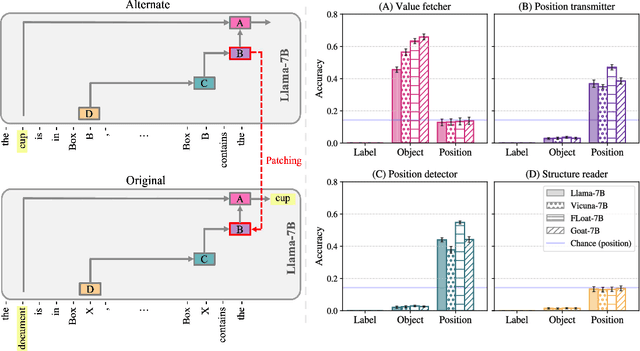
Abstract:Fine-tuning on generalized tasks such as instruction following, code generation, and mathematics has been shown to enhance language models' performance on a range of tasks. Nevertheless, explanations of how such fine-tuning influences the internal computations in these models remain elusive. We study how fine-tuning affects the internal mechanisms implemented in language models. As a case study, we explore the property of entity tracking, a crucial facet of language comprehension, where models fine-tuned on mathematics have substantial performance gains. We identify the mechanism that enables entity tracking and show that (i) in both the original model and its fine-tuned versions primarily the same circuit implements entity tracking. In fact, the entity tracking circuit of the original model on the fine-tuned versions performs better than the full original model. (ii) The circuits of all the models implement roughly the same functionality: Entity tracking is performed by tracking the position of the correct entity in both the original model and its fine-tuned versions. (iii) Performance boost in the fine-tuned models is primarily attributed to its improved ability to handle the augmented positional information. To uncover these findings, we employ: Patch Patching, DCM, which automatically detects model components responsible for specific semantics, and CMAP, a new approach for patching activations across models to reveal improved mechanisms. Our findings suggest that fine-tuning enhances, rather than fundamentally alters, the mechanistic operation of the model.
A Vision Check-up for Language Models
Jan 03, 2024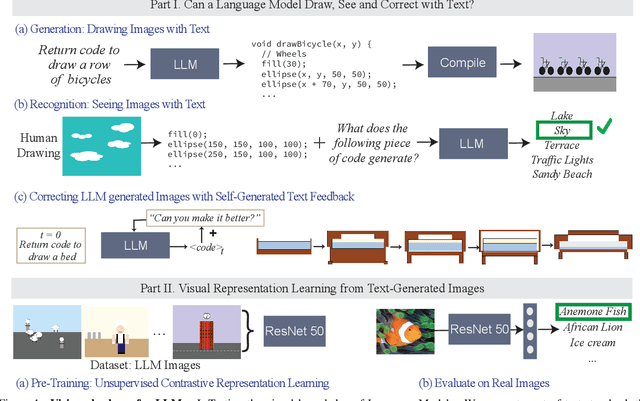
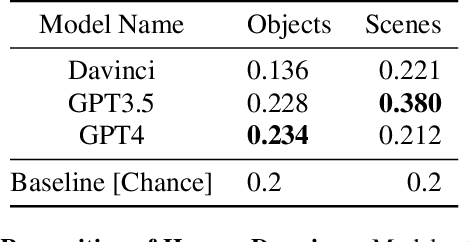
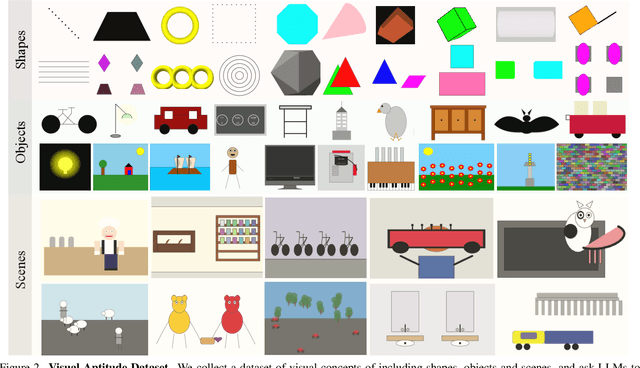
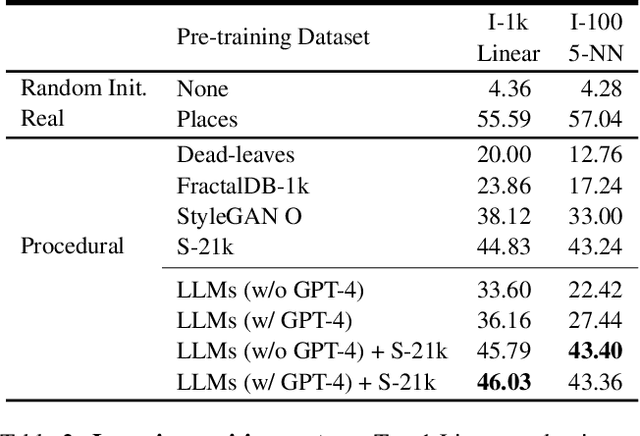
Abstract:What does learning to model relationships between strings teach large language models (LLMs) about the visual world? We systematically evaluate LLMs' abilities to generate and recognize an assortment of visual concepts of increasing complexity and then demonstrate how a preliminary visual representation learning system can be trained using models of text. As language models lack the ability to consume or output visual information as pixels, we use code to represent images in our study. Although LLM-generated images do not look like natural images, results on image generation and the ability of models to correct these generated images indicate that precise modeling of strings can teach language models about numerous aspects of the visual world. Furthermore, experiments on self-supervised visual representation learning, utilizing images generated with text models, highlight the potential to train vision models capable of making semantic assessments of natural images using just LLMs.
A Function Interpretation Benchmark for Evaluating Interpretability Methods
Sep 07, 2023



Abstract:Labeling neural network submodules with human-legible descriptions is useful for many downstream tasks: such descriptions can surface failures, guide interventions, and perhaps even explain important model behaviors. To date, most mechanistic descriptions of trained networks have involved small models, narrowly delimited phenomena, and large amounts of human labor. Labeling all human-interpretable sub-computations in models of increasing size and complexity will almost certainly require tools that can generate and validate descriptions automatically. Recently, techniques that use learned models in-the-loop for labeling have begun to gain traction, but methods for evaluating their efficacy are limited and ad-hoc. How should we validate and compare open-ended labeling tools? This paper introduces FIND (Function INterpretation and Description), a benchmark suite for evaluating the building blocks of automated interpretability methods. FIND contains functions that resemble components of trained neural networks, and accompanying descriptions of the kind we seek to generate. The functions are procedurally constructed across textual and numeric domains, and involve a range of real-world complexities, including noise, composition, approximation, and bias. We evaluate new and existing methods that use language models (LMs) to produce code-based and language descriptions of function behavior. We find that an off-the-shelf LM augmented with only black-box access to functions can sometimes infer their structure, acting as a scientist by forming hypotheses, proposing experiments, and updating descriptions in light of new data. However, LM-based descriptions tend to capture global function behavior and miss local corruptions. These results show that FIND will be useful for characterizing the performance of more sophisticated interpretability methods before they are applied to real-world models.
Discovering Variable Binding Circuitry with Desiderata
Jul 07, 2023



Abstract:Recent work has shown that computation in language models may be human-understandable, with successful efforts to localize and intervene on both single-unit features and input-output circuits. Here, we introduce an approach which extends causal mediation experiments to automatically identify model components responsible for performing a specific subtask by solely specifying a set of \textit{desiderata}, or causal attributes of the model components executing that subtask. As a proof of concept, we apply our method to automatically discover shared \textit{variable binding circuitry} in LLaMA-13B, which retrieves variable values for multiple arithmetic tasks. Our method successfully localizes variable binding to only 9 attention heads (of the 1.6k) and one MLP in the final token's residual stream.
Internal Diverse Image Completion
Dec 18, 2022



Abstract:Image completion is widely used in photo restoration and editing applications, e.g. for object removal. Recently, there has been a surge of research on generating diverse completions for missing regions. However, existing methods require large training sets from a specific domain of interest, and often fail on general-content images. In this paper, we propose a diverse completion method that does not require a training set and can thus treat arbitrary images from any domain. Our internal diverse completion (IDC) approach draws inspiration from recent single-image generative models that are trained on multiple scales of a single image, adapting them to the extreme setting in which only a small portion of the image is available for training. We illustrate the strength of IDC on several datasets, using both user studies and quantitative comparisons.
BlendGAN: Learning and Blending the Internal Distributions of Single Images by Spatial Image-Identity Conditioning
Dec 03, 2022Abstract:Training a generative model on a single image has drawn significant attention in recent years. Single image generative methods are designed to learn the internal patch distribution of a single natural image at multiple scales. These models can be used for drawing diverse samples that semantically resemble the training image, as well as for solving many image editing and restoration tasks that involve that particular image. Here, we introduce an extended framework, which allows to simultaneously learn the internal distributions of several images, by using a single model with spatially varying image-identity conditioning. Our BlendGAN opens the door to applications that are not supported by single-image models, including morphing, melding, and structure-texture fusion between two or more arbitrary images.
Catch-A-Waveform: Learning to Generate Audio from a Single Short Example
Jun 11, 2021



Abstract:Models for audio generation are typically trained on hours of recordings. Here, we illustrate that capturing the essence of an audio source is typically possible from as little as a few tens of seconds from a single training signal. Specifically, we present a GAN-based generative model that can be trained on one short audio signal from any domain (e.g. speech, music, etc.) and does not require pre-training or any other form of external supervision. Once trained, our model can generate random samples of arbitrary duration that maintain semantic similarity to the training waveform, yet exhibit new compositions of its audio primitives. This enables a long line of interesting applications, including generating new jazz improvisations or new a-cappella rap variants based on a single short example, producing coherent modifications to famous songs (e.g. adding a new verse to a Beatles song based solely on the original recording), filling-in of missing parts (inpainting), extending the bandwidth of a speech signal (super-resolution), and enhancing old recordings without access to any clean training example. We show that in all cases, no more than 20 seconds of training audio commonly suffice for our model to achieve state-of-the-art results. This is despite its complete lack of prior knowledge about the nature of audio signals in general.
 Add to Chrome
Add to Chrome Add to Firefox
Add to Firefox Add to Edge
Add to Edge